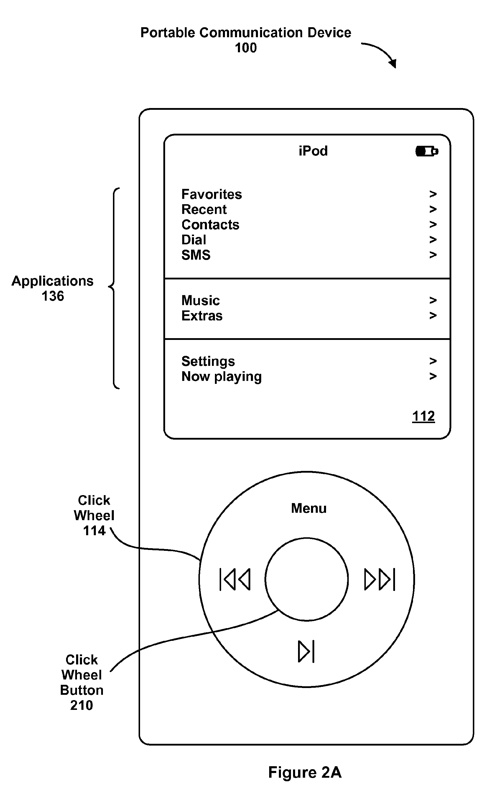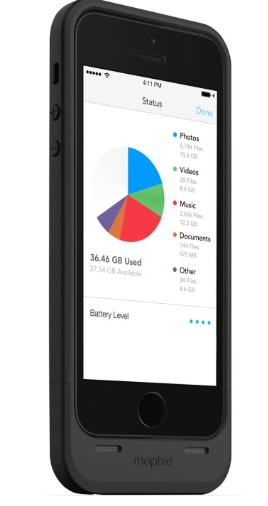Apple has been awarded a patent from the US Patent & Trademark Office for a device that looks like an iPod classic with dialing capabilities. The invention relates generally to portable communications devices, and more particularly, to portable communications devices that include a click wheel.
Apple patent 7,667,148 is for a method, device and graphical user interface for dialing with a click wheel. One aspect of the invention involves a computer-implemented method in which a portable communications device with a click wheel and a display detects a plurality of finger contacts with the click wheel. Each finger contact includes an angular displacement of the finger contact on the click wheel between an initial location and a final location of the finger contact. The device displays an image that includes digits arranged in a circle. The image rotates, in response to each finger contact, by an amount determined in accordance with the angular displacement of the finger contact. For each finger contact, the device determines a digit. The determined digit is independent of the initial location of the finger contact on the click wheel. The device performs a task using the determined digits. Exemplary tasks include dialing a telephone number and sending numeric input to a remote computer. The inventors are Philip Andrew Mansfield and Michael Robert Levy.
Here’s Apple’s background and summary of the invention: “As portable communications devices become more compact, and the amount of information to be processed and stored increases, it has become a significant challenge to design a user interface that allows users to easily interact with the device. This is unfortunate because the user interface is the gateway through which users receive not only content but also responses to user actions or behaviors, including user attempts to access a device’s features or tools. Some portable communication devices (e.g., mobile telephones, sometimes called mobile phones, cell phones, cellular telephones, and the like) have resorted to adding more pushbuttons, increasing the density of push buttons, overloading the functions of pushbuttons, or using complex menu systems to allow a user to access, store and manipulate data.
“These conventional user interfaces often result in complicated key sequences and menu hierarchies that must be memorized by the user. In addition, as the number of pushbuttons has increased, the proximity of neighboring buttons often makes it difficult for users to activate a desired pushbutton. Accordingly, there is a need for more transparent and intuitive user interfaces for portable communication devices.
“The above deficiencies and other problems associated with user interfaces for portable communications devices are reduced or eliminated by the disclosed devices that use a click wheel to perform tasks, such as dialing telephone numbers.
“One aspect of the invention involves a computer-implemented method in which a portable communications device with a click wheel and a display detects a plurality of finger contacts with the click wheel. Each finger contact includes an angular displacement of the finger contact on the click wheel between an initial location and a final location of the finger contact on the click wheel. The device displays an image that includes digits arranged in a circle. The image rotates in response to each finger contact by an amount determined in accordance with the angular displacement of the finger contact. For each finger contact, the device determines a digit. The determined digit is independent of the initial location of the finger contact on the click wheel. The device performs a task using the determined digits. Exemplary tasks include dialing a telephone number and sending numeric input to a remote computer.
Another aspect of the invention involves a graphical user interface (GUI) on a portable communications device with a click wheel and a display. The GUI has an image that includes digits arranged in a circle. The image rotates in response to each finger contact in a plurality of finger contacts. Each finger contact includes an angular displacement of the finger contact on the click wheel between an initial location and a final location of the finger contact on the click wheel. For each finger contact, the amount of rotation of the image is determined in accordance with the angular displacement of the finger contact. For each finger contact, a digit is determined. The determined digit is independent of the initial location of the finger contact on the click wheel. A task is performed using the determined digits.
“Another aspect of the invention involves a portable communications device. The device includes a click wheel, a display, one or more processors, memory, and a program The program is stored in the memory and configured to be executed by the one or more processors. The program includes instructions for detecting a plurality of finger contacts with the click wheel. Each finger contact includes an angular displacement of the finger contact on the click wheel between an initial location and a final location of the finger contact on the click wheel. The program also includes instructions for displaying an image that includes digits arranged in a circle. The image rotates in response to each finger contact by an amount determined in accordance with the angular displacement of the finger contact. The program also includes, for each finger contact, instructions for determining a digit. The determined digit is independent of the initial location of the finger contact on the click wheel. The program also includes instructions for performing a task using the determined digits.
“Another aspect of the invention involves a computer-program product that includes a computer readable storage medium and a computer program mechanism embedded therein. The computer program mechanism includes instructions, which when executed by a portable communications device with a click wheel and a display, cause the device to: detect a plurality of finger contacts with the click wheel, wherein each finger contact includes an angular displacement of the finger contact on the click wheel between an initial location and a final location of the finger contact on the click wheel; display an image that includes digits arranged in a circle, wherein: the image rotates in response to each finger contact by an amount determined in accordance with the angular displacement of the finger contact; for each finger contact, determine a digit, wherein the determined digit is independent of the initial location of the finger contact on the click wheel; and perform a task using the determined digits.
“Another aspect of the invention involves a portable communications device with a click wheel and a display, comprising: means for detecting a plurality of finger contacts with the click wheel, wherein each finger contact includes an angular displacement of the finger contact on the click wheel between an initial location and a final location of the finger contact on the click wheel; means for displaying an image that includes digits arranged in a circle, wherein: the image rotates in response to each finger contact by an amount determined in accordance with the angular displacement of the finger contact; for each finger contact, means for determining a digit, wherein the determined digit is independent of the initial location of the finger contact on the click wheel; and means for performing a task using the determined digits.
Thus, the invention provides a user interface for inputting data (e.g., telephone numbers) that is reminiscent of, but improves upon, the mechanical rotary dial found on old landline telephones.”



